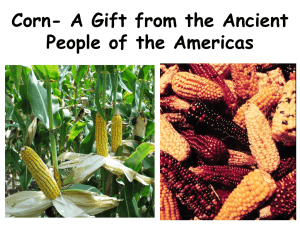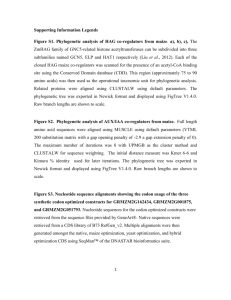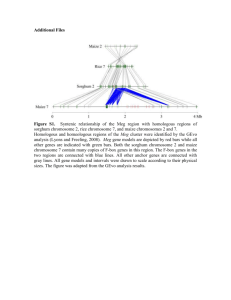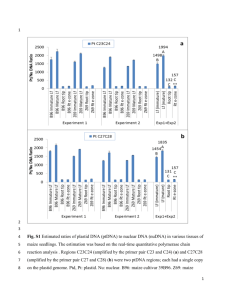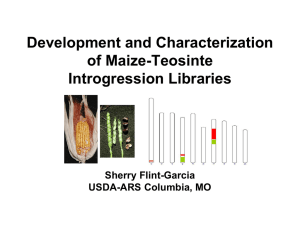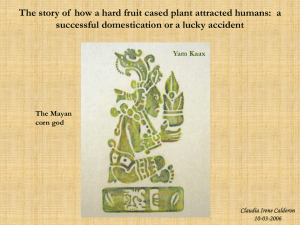Name: Core: ______ Selective Breeding of Corn http://learn
advertisement
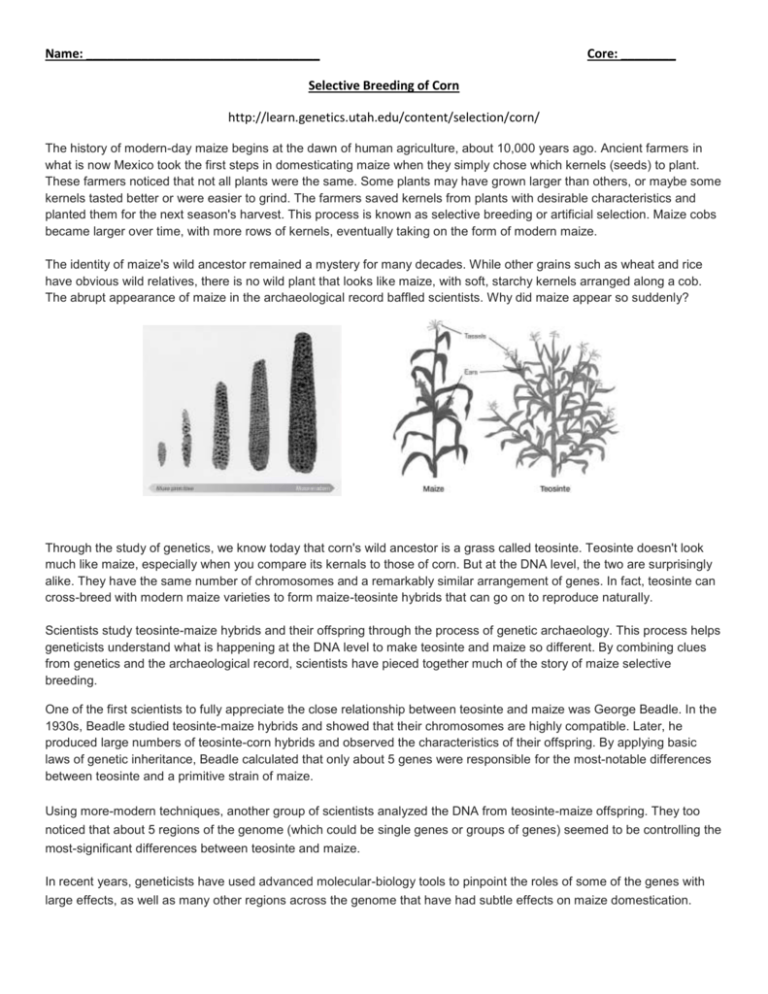
Name: __________________________________ Core: ________ Selective Breeding of Corn http://learn.genetics.utah.edu/content/selection/corn/ The history of modern-day maize begins at the dawn of human agriculture, about 10,000 years ago. Ancient farmers in what is now Mexico took the first steps in domesticating maize when they simply chose which kernels (seeds) to plant. These farmers noticed that not all plants were the same. Some plants may have grown larger than others, or maybe some kernels tasted better or were easier to grind. The farmers saved kernels from plants with desirable characteristics and planted them for the next season's harvest. This process is known as selective breeding or artificial selection. Maize cobs became larger over time, with more rows of kernels, eventually taking on the form of modern maize. The identity of maize's wild ancestor remained a mystery for many decades. While other grains such as wheat and rice have obvious wild relatives, there is no wild plant that looks like maize, with soft, starchy kernels arranged along a cob. The abrupt appearance of maize in the archaeological record baffled scientists. Why did maize appear so suddenly? Through the study of genetics, we know today that corn's wild ancestor is a grass called teosinte. Teosinte doesn't look much like maize, especially when you compare its kernals to those of corn. But at the DNA level, the two are surprisingly alike. They have the same number of chromosomes and a remarkably similar arrangement of genes. In fact, teosinte can cross-breed with modern maize varieties to form maize-teosinte hybrids that can go on to reproduce naturally. Scientists study teosinte-maize hybrids and their offspring through the process of genetic archaeology. This process helps geneticists understand what is happening at the DNA level to make teosinte and maize so different. By combining clues from genetics and the archaeological record, scientists have pieced together much of the story of maize selective breeding. One of the first scientists to fully appreciate the close relationship between teosinte and maize was George Beadle. In the 1930s, Beadle studied teosinte-maize hybrids and showed that their chromosomes are highly compatible. Later, he produced large numbers of teosinte-corn hybrids and observed the characteristics of their offspring. By applying basic laws of genetic inheritance, Beadle calculated that only about 5 genes were responsible for the most-notable differences between teosinte and a primitive strain of maize. Using more-modern techniques, another group of scientists analyzed the DNA from teosinte-maize offspring. They too noticed that about 5 regions of the genome (which could be single genes or groups of genes) seemed to be controlling the most-significant differences between teosinte and maize. In recent years, geneticists have used advanced molecular-biology tools to pinpoint the roles of some of the genes with large effects, as well as many other regions across the genome that have had subtle effects on maize domestication. The earliest events in maize domestication likely involved small changes to single genes with dramatic effects. We know the events were early because there is little variation in these genes between maize varieties, suggesting that modern varieties are descended from a single ancestor. That the small changes had dramatic effects also explains the sudden appearance of maize in the archaeological record. Later changes in the selective breeding of modern maize involved many genes (perhaps thousands) with small effects. These minor changes include the following: Types and amounts of starch production Ability to grow in different climates and types of soil Length and number of kernel rows Kernel size, shape, and color Resistance to pests Local groups of farmers selected for characteristics that they preferred, and that worked best in their particular environment. Over thousands of years, selective breeding generated the broad diversity of corn varieties that are still grown around the world today. READING QUESTIONS (Answer in complete sentences!) 1. How did ancient farmers in Mexico contribute to the selective breeding of corn/maize? (Hint: What did they notice? What did they do?) 2. What is the wild ancestor of corn and how is it genetically similar to corn? 3. How did the scientist George Beadle contribute to our understanding of corn’s genetics? 4. What other traits does modern corn have as a result of selective breeding?
